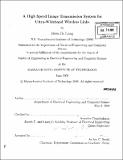| dc.contributor.advisor | Anantha Chandrakasan. | en_US |
| dc.contributor.author | Liang, Helen He | en_US |
| dc.contributor.other | Massachusetts Institute of Technology. Dept. of Electrical Engineering and Computer Science. | en_US |
| dc.date.accessioned | 2010-03-25T15:07:33Z | |
| dc.date.available | 2010-03-25T15:07:33Z | |
| dc.date.copyright | 2009 | en_US |
| dc.date.issued | 2009 | en_US |
| dc.identifier.uri | http://hdl.handle.net/1721.1/53151 | |
| dc.description | Thesis (M. Eng.)--Massachusetts Institute of Technology, Dept. of Electrical Engineering and Computer Science, 2009. | en_US |
| dc.description | Includes bibliographical references (p. 97-98). | en_US |
| dc.description.abstract | Ultra-wideband (UWB) communication is an emerging technology that offers short range, high data rate wireless transmission, with low power consumption and low consumer cost. Operating in the 3.1 GHz - 10.6 GHz frequency band with bandwidth above 500 MHz, it is an overlay technology that can co-exist with other narrowband services in the same frequency range, thus alleviating the problem of over-crowded spectrum. In particular, pulse-based UWB technologies allows for building of ultra-low power, medium- to long-range transceivers, at the expense of data transmission rate. This thesis presents a pulse-based, non-coherent UWB wireless image transmission platform. The system features a one-way wireless link. On the transmitter side, a host PC processes the images into transmittable packets in MATLAB, and sends them to the UWB radio through an interfacing FPGA module. On the receiver side, the UWB receiver radio receivers the packets, decodes the bits, and passes them back to the receiver host PC through another interfacing FPGA module. The receiver host PC collects the decoded bits and reconstructs the original image in MATLAB. The unidirectional wireless channel is complemented by a feedback path, provided through internet connection between the two host PCs. To improve usability, graphical user interfaces are setup on both host PCs. The overall system transmits 120 x 160 uncompressed bitmap images. It achieves a maximum payload data rate of 8 Mb/s. | en_US |
| dc.description.abstract | (cont.) It is able to transmit data reliably, with above 95% packet reception rate and below 2 x 10-5 bit error rate, for distances up to 16 meters. At 16 meters, the system has a maximum transmission data rate of 2.67 Mbps. | en_US |
| dc.description.statementofresponsibility | by Helen He Liang. | en_US |
| dc.format.extent | 98 p. | en_US |
| dc.language.iso | eng | en_US |
| dc.publisher | Massachusetts Institute of Technology | en_US |
| dc.rights | M.I.T. theses are protected by
copyright. They may be viewed from this source for any purpose, but
reproduction or distribution in any format is prohibited without written
permission. See provided URL for inquiries about permission. | en_US |
| dc.rights.uri | http://dspace.mit.edu/handle/1721.1/7582 | en_US |
| dc.subject | Electrical Engineering and Computer Science. | en_US |
| dc.title | A high speed image transmission system for ultra-wideband wireless links | en_US |
| dc.type | Thesis | en_US |
| dc.description.degree | M.Eng. | en_US |
| dc.contributor.department | Massachusetts Institute of Technology. Department of Electrical Engineering and Computer Science | |
| dc.identifier.oclc | 505571988 | en_US |
